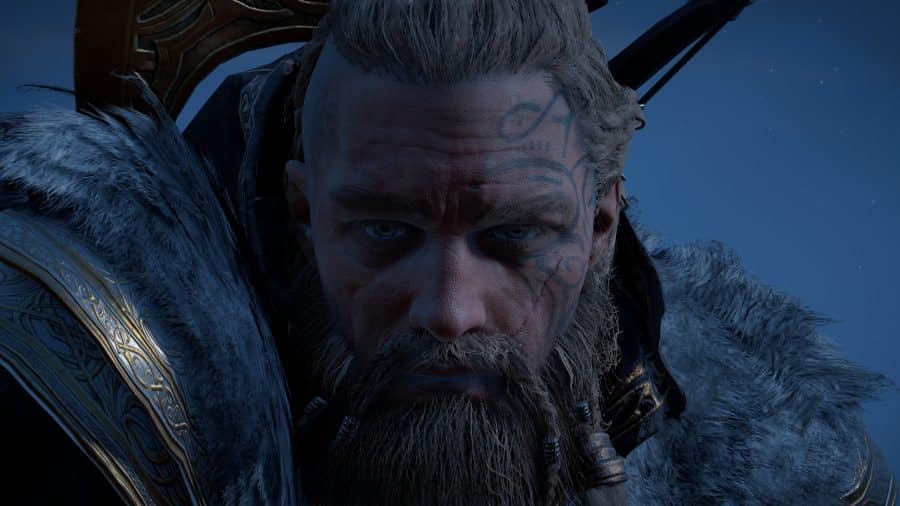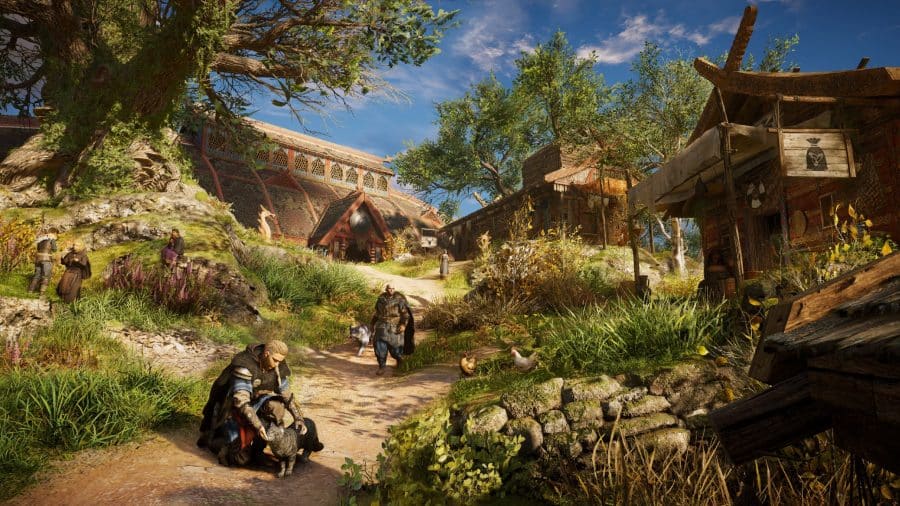Assassin’s Creed Valhalla
It seemed fitting that the first game I played on my Xbox Series X was an Assassin’s Creed title. Similar to the previous generation, I broke in my PS4 playing Black Flag. In all honesty, I had no intentions on even playing Valhalla. As much as I loved the earlier games in the franchise, I grew tired of the annual release cycle, and didn’t like the RPG direction they headed with Origins in 2017. Frankly, they were too big and didn’t respect the player’s time. I played both Origins and Odyssey, but never got more than 40 hours in before open-world fatigue set in. I only picked up Valhalla because I wanted something next-gen to play on my new Xbox. With Valhalla supporting 4K at 60 FPS out of the gate, I bit the bullet and gave Assassin’s Creed another shot. And let me tell you, I’m sure glad I did! Assassin’s Creed Valhalla is the best game in the franchise since Black Flag, as far as I’m concerned.
Even thought I played in performance mode, the jump in graphical fidelity was definitely noticeable. The screenshot above was taken during gameplay using the in-game photo mode. I was blown away when I got right up in Eivor’s face, at the level of detail. You can clearly see pores, the depth of the scar on his cheek, and individual eyebrow hairs.
Assassin’s Creed games have come a long way. They’ve always been open-world, but they used to be far more linear. I was overwhelmed by the previous two titles within an hour of starting the journey, simply by looking at the map. I knew Valhalla was a big game, but it didn’t fully reveal its true size and scope until much later. It always felt manageable, and before I knew it I had invested over 60 hours into Eivor’s story, and was sad that it was coming to an end.
Play Your Way
I have to commend Ubisoft on the sheer amount of accessibility features they’ve packed into Valhalla. You can literally mould the gameplay to your liking. With individual difficulty levels for combat, stealth, and exploration. Along with settings to tweak aim assist and enable “guaranteed assassination”, which is the gold old one-hit hidden blade kill. If the latter is disabled, you are faced with a QTE for more challenging enemies who can’t be killed with a single hit. There are also settings for blood FX and dismemberment, which are handy for when the kids are around.
It’s clear that Ubisoft is making huge effects to be as accessible and inclusive as possible. Like Odyssey, you can choose to play as a male or female character. But this time, you play as Eivor either way, and you can switch the sex at any given moment. Typically, given the choice I’ll play as a female character. I started Valahalla playing as female Eivor, but it wasn’t resonating with me, so I started over as male Eivor and it felt much better.
Story, Combat, and Mechanics
I know a fair bit about vikings, having watched the History Channel series twice from beginning to end. I really enjoyed the exploits of Ragnar and his sons, and it was neat to see how Ubisoft featured them, but without making them the primary focus. Eivor’s tale takes place long after Ragnar’s time, and toward the end of his sons’. Even still, there are countless references to Ragnar’s legacy.
Once you get the hang of it, combat is fun and satisfying. To circle back to the accessibility topic, Valhalla lets you fight however you want as well. From your approach, to your loadout, to the types of weapons at your disposal — the choices are yours. If you’d like to run around in your underwear with nothing but a bow and a dagger, you can do that. Or if you’d like to be armed to the teeth with the heaviest armour and a two-handed axe, you can do that. I found myself somewhere in the middle, with modest armour and heavy weapons. But I switched it up several times through-out my time with Eivor. I enjoyed moving quicker with smaller axes in each hand when it came to raids.
Speaking of raids — what would a viking game be without raids? This is a pretty cool mechanic, which can be evoked at any time, even during missions. There are strongholds and monasteries along the rivers which you can raid simply by visiting, but you’ll want to make sure you check the difficulty level before you commit. I made this mistake on more than one occasion, and found myself getting pummelled without reprieve. Raids will reward you with riches and resources which can be used to upgrade your settlement.
Which brings me to our next topic. Other games in the series have given you a place to call home, and even let you furnish and upgrade it, but not like Valhalla. Here you build vendor stalls and housing for your allies, barracks and a shipyard to help you succeed out in the field, and add decorations through-out to make it feel unique. It was always exciting heading back to the settlement after a prosperous journey and seeing how many upgrades I could afford.
When I started out, I had planned to stick to the main story while completing minimal side quests. I’m not a fan of fetch quests, or other mundane tasks that feel like a waste of time. While there are certainly time-wasters and even silly tasks in Valhalla, I quite enjoyed the majority of them and found myself completing just about everything that was set before me. Part of this is due to the side quests (or world activities, as they’re called in Valhalla) are usually short and don’t take you too far out of the way. Overall, I really enjoyed this world that Ubisoft created and have found myself going back to complete world events long after the story wrapped up.
Bumps in the Road
Open-world games are notorious for bugs that often never get resolved. Valhalla is no exception, especially at launch it had a number of annoying bugs. Some that even prevented mission progress. Thankfully, those were ironed out pretty soon after release, and the game continued to improve over the months ahead. Entire systems were redeveloped and improved based on community feedback and the end result, while certainly not perfect, is far better than it was initially. IMO, the bugs can easily be overlooked by the sheer amount of enjoyable hours Valhalla supplies.
One bug that really annoyed me though, is actually a hardware issue with the Xbox Series X. I haven’t noticed it lately, but for the first few months after release, launching a game via Quick Resume would often result in music being absent. I didn’t realize this was happening until I reached a very dramatic scene in Valhalla, and it was nearly silent and lacking any sense of drama due to the lack of music. At that point, I did some research and discovered others experiencing the same issue on the Series X. From that point on, I always reloaded Valhalla to ensure I wasn’t missing the glorious soundtrack.
Final Thoughts
I started writing this review back in March, and am only now finishing it in September, nearly a year since the game was released. When I saw it sitting in my drafts, I felt like I owed it to Ubisoft to publish it. Assassin’s Creed Valhalla took me by surprise and exceeded my expectations at every turn. I’ll look back on this game in years to come with the same fond memories I have of the first few games and Black Flag. In the end, I sunk about 110 hours into the core game, and dozens more into the Wrath of the Druids and The Siege of Paris expansions.


